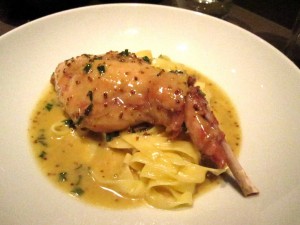In today’s Fresh From Our Farmers, which you can read here, I promise to post a few recipes for rabbit. Here they are. Once you get the hang of it, cooking rabbit is quite easy. But there is a learning curve, because it vanished from American kitchens for decades and has only recently begun making a comeback.
If you need a lesson in cutting up a whole rabbit, check out youtube.com, where you’ll find several instructional videos.
Rabbit Dijonnaise From Pairings,June 11, 2008. In this recipe, rabbit is paired with a delicious wine, Arrowood’s 2006 Russian River Valley Viognier.
Lydie Marshall’s Fricassee de Lapin à l’Aioli * Serves 4
This recipe, adapted from Chez Nous: Home Cooking from the South of France by Lydie Marshall (HarperCollins, 1995), is a good first recipe for anyone who has never cooked rabbit. The aioli, served alongside, will cover up most mistakes, such as overcooking the rabbit.
1 2 1/2 to 3 pound rabbit, cut into 10 pieces
for the marinade
- Kosher salt
- 10 large garlic cloves
- 2 fresh thyme sprigs
- 1 fresh rosemary sprig
- Black pepper in a mill
- 1 tablespoon olive oil
- 1 cup robust red wine, such as zinfandel or a Rhone-style red
for the rabbit
- 1/2 cup olive oil
- 2 cups diced tomatoes, either canned or frozen
- 1 cup light chicken stock or broth, preferably homemade
- Kosher salt
- Black pepper in a mill
to serve
- Aioli (recipe follows)
- 1 1/2 pounds small new potatoes, steamed
- Put the rabbit into a large bowl and season it all over with salt. Add the garlic, herbs, several turns of black pepper, olive oil and wine. Gently turn the rabbit in the mixture. Cover and refrigerate for at least eight hours or as long as over night.
- Drain the rabbit, reserving the marinade.
- Pat the rabbit and garlic cloves with paper towels or a clean tea towel.
- Pour the olive oil into a large skillet set over high heat. When the oil is very hot, fry the rabbit, turning frequently, until it is golden brown all over. Do not crowd the pan and work in batches if necessary.
- Transfer the browned rabbit to a boil. Reduce the heat to medium and fry the garlic, turning frequently, until it is golden brown; do not let it burn. Transfer the garlic to the plate with the rabbit.
- Add the tomatoes and cook for 2 minutes.
- Pour the reserved marinade and the broth into the pan with the tomatoes and bring to a boil. Simmer for 5 minutes.
- Season the rabbit and garlic with salt and pepper and add to the pan, turning the rabbit to coat it in sauce. Reduce the heat to very low, cover the pan and simmer for 1 hour, turning the rabbit occasionally.
- While the rabbit simmers, steam the potatoes and make the aioli.
- To serve, transfer the rabbit and the garlic cloves to a warm serving dish. Add the potatoes to the dish.
- Strain and degrease the sauce and pour it over the rabbit and potatoes.
- Serve immediately, with aioli alongside.
Aioli • Makes about 1 1/4 cups
If you have a French-style olive oil, such as one made from picholine olives, use it in this recipe; it makes a suave sauce that is mild yet flavorful.
- 6 large garlic cloves, peeled
- Kosher salt
- 2 egg yolks, at room temperature
- 1 cup best-quality olive oil, preferably mild
- 1 lemon
- White pepper in a mill
- Put the garlic and two or three generous pinches of salt into a large mortar and use the pestle to crush the garlic. Grind the garlic and salt until it forms a smooth paste. Mix in the eggs or egg yolks.
- Using a whisk, begin to add the olive oil, just a little at a time. As the emulsion forms and grows thick, you can add the oil a little more quickly, whisking all the while. When all of the oil has been added, taste the sauce. Add a squeeze of lemon juice, tilting the bowl so that it pools to one side. Add as much salt as you think the sauce will need to the lemon juice and agitate the bowl gently to dissolve it. Whisk the salty juice into the aioli. Taste and add more lemon juice and salt as needed.
- Let the mixture rest, covered, in the refrigerator for 30 minutes to 2 hours before using.
Patricia Wells’s Lapin a la Moutarde • Serves 4
There is no finer writer on the subject of French food than Patricia Wells. This recipe, from Wells’s fourth edition of “The Food Lover’s Guide to Paris” (Workman Publishing, 1999), presents one of the most traditional ways to serve rabbit. Yet another book, “Patricia Wells at Home in Provence” (Scribner, 1996) explores the subject of rabbit in finer detail, with several regional recipes that will delight the aficionado. The fresh pasta is my addition; I like the way its tenderness cushions the rabbit.
- 1/3 cup peanut oil
- 1 tablespoon unsalted butter
- 1 fresh rabbit, 2 1/2 to 3 pounds, cut into pieces
- Kosher salt
- 1/2 cup French whole grain mustard
- 3 cups dry white wine
- 1 cup creme fraiche
- Black pepper in a mill
- 2 to 3 tablespoons minced fresh parsley
- 12 ounces fresh pappardelle or fettuccine
- Preheat the oven to 350 degrees.
- Pour the oil into a large oven-proof pot, such as a Dutch oven, set over medium high heat. Add the butter and when it is melted, add the rabbit and quickly brown it on all sides. Transfer the browned rabbit to a plate and discard excess oil, leaving just a little in the pan.
- Season the rabbit with salt. Set aside 3 tablespoons of the mustard and brush the rest over the pieces of rabbit. Return the rabbit to the pot and bake, covered for 15 minutes.
- Pour the wine over the rabbit and bake for 25 minutes more.
- Remove the pot from the oven, reduce the heat to 200 degrees and use tongs to transfer the rabbit to a baking sheet. Cover the rabbit with foil and when the oven is cooled set the rabbit on the middle shelf to keep warm.
- Set the pot over high heat and simmer for 10 minutes, or until the cooking liquid is reduced by half. Whisk in the reserved mustard and the creme fraiche and season with several turns of black pepper. Simmer for 4 minutes, taste and correct the seasoning.
- Meanwhile, bring a large pot of salted water to a boil and cook the fettucine until it is just tender. Drain the pasta, do not rinse and transfer it to a warm platter or shallow bowl.
- Arrange the rabbit on top of the pasta. Pour the sauce over it all, sprinkle with minced parsley and serve immediately.
Variation: For a somewhat less traditional but more suave version of this dish, use an imported Dijon, such as PIC, in place of the whole grain mustard.


